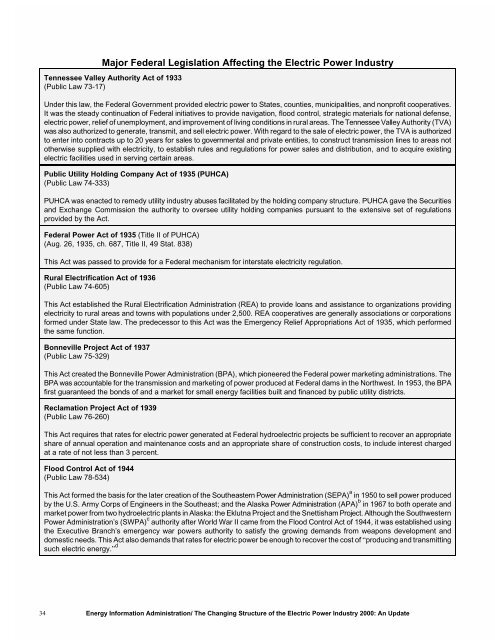The Changing Structure of the Electric Power Industry 2000: An ... - EIA
The Changing Structure of the Electric Power Industry 2000: An ... - EIA
The Changing Structure of the Electric Power Industry 2000: An ... - EIA
You also want an ePaper? Increase the reach of your titles
YUMPU automatically turns print PDFs into web optimized ePapers that Google loves.
34<br />
Major Federal Legislation Affecting <strong>the</strong> <strong>Electric</strong> <strong>Power</strong> <strong>Industry</strong><br />
Tennessee Valley Authority Act <strong>of</strong> 1933<br />
(Public Law 73-17)<br />
Under this law, <strong>the</strong> Federal Government provided electric power to States, counties, municipalities, and nonpr<strong>of</strong>it cooperatives.<br />
It was <strong>the</strong> steady continuation <strong>of</strong> Federal initiatives to provide navigation, flood control, strategic materials for national defense,<br />
electric power, relief <strong>of</strong> unemployment, and improvement <strong>of</strong> living conditions in rural areas. <strong>The</strong> Tennessee Valley Authority (TVA)<br />
was also authorized to generate, transmit, and sell electric power. With regard to <strong>the</strong> sale <strong>of</strong> electric power, <strong>the</strong> TVA is authorized<br />
to enter into contracts up to 20 years for sales to governmental and private entities, to construct transmission lines to areas not<br />
o<strong>the</strong>rwise supplied with electricity, to establish rules and regulations for power sales and distribution, and to acquire existing<br />
electric facilities used in serving certain areas.<br />
Public Utility Holding Company Act <strong>of</strong> 1935 (PUHCA)<br />
(Public Law 74-333)<br />
PUHCA was enacted to remedy utility industry abuses facilitated by <strong>the</strong> holding company structure. PUHCA gave <strong>the</strong> Securities<br />
and Exchange Commission <strong>the</strong> authority to oversee utility holding companies pursuant to <strong>the</strong> extensive set <strong>of</strong> regulations<br />
provided by <strong>the</strong> Act.<br />
Federal <strong>Power</strong> Act <strong>of</strong> 1935 (Title II <strong>of</strong> PUHCA)<br />
(Aug. 26, 1935, ch. 687, Title II, 49 Stat. 838)<br />
This Act was passed to provide for a Federal mechanism for interstate electricity regulation.<br />
Rural Electrification Act <strong>of</strong> 1936<br />
(Public Law 74-605)<br />
This Act established <strong>the</strong> Rural Electrification Administration (REA) to provide loans and assistance to organizations providing<br />
electricity to rural areas and towns with populations under 2,500. REA cooperatives are generally associations or corporations<br />
formed under State law. <strong>The</strong> predecessor to this Act was <strong>the</strong> Emergency Relief Appropriations Act <strong>of</strong> 1935, which performed<br />
<strong>the</strong> same function.<br />
Bonneville Project Act <strong>of</strong> 1937<br />
(Public Law 75-329)<br />
This Act created <strong>the</strong> Bonneville <strong>Power</strong> Administration (BPA), which pioneered <strong>the</strong> Federal power marketing administrations. <strong>The</strong><br />
BPA was accountable for <strong>the</strong> transmission and marketing <strong>of</strong> power produced at Federal dams in <strong>the</strong> Northwest. In 1953, <strong>the</strong> BPA<br />
first guaranteed <strong>the</strong> bonds <strong>of</strong> and a market for small energy facilities built and financed by public utility districts.<br />
Reclamation Project Act <strong>of</strong> 1939<br />
(Public Law 76-260)<br />
This Act requires that rates for electric power generated at Federal hydroelectric projects be sufficient to recover an appropriate<br />
share <strong>of</strong> annual operation and maintenance costs and an appropriate share <strong>of</strong> construction costs, to include interest charged<br />
at a rate <strong>of</strong> not less than 3 percent.<br />
Flood Control Act <strong>of</strong> 1944<br />
(Public Law 78-534)<br />
This Act formed <strong>the</strong> basis for <strong>the</strong> later creation <strong>of</strong> <strong>the</strong> Sou<strong>the</strong>astern <strong>Power</strong> Administration (SEPA) a in 1950 to sell power produced<br />
by <strong>the</strong> U.S. Army Corps <strong>of</strong> Engineers in <strong>the</strong> Sou<strong>the</strong>ast; and <strong>the</strong> Alaska <strong>Power</strong> Administration (APA) b in 1967 to both operate and<br />
market power from two hydroelectric plants in Alaska: <strong>the</strong> Eklutna Project and <strong>the</strong> Snettisham Project. Although <strong>the</strong> Southwestern<br />
<strong>Power</strong> Administration’s (SWPA) c authority after World War II came from <strong>the</strong> Flood Control Act <strong>of</strong> 1944, it was established using<br />
<strong>the</strong> Executive Branch’s emergency war powers authority to satisfy <strong>the</strong> growing demands from weapons development and<br />
domestic needs. This Act also demands that rates for electric power be enough to recover <strong>the</strong> cost <strong>of</strong> “producing and transmitting<br />
such electric energy.” d<br />
Energy Information Administration/ <strong>The</strong> <strong>Changing</strong> <strong>Structure</strong> <strong>of</strong> <strong>the</strong> <strong>Electric</strong> <strong>Power</strong> <strong>Industry</strong> <strong>2000</strong>: <strong>An</strong> Update

















